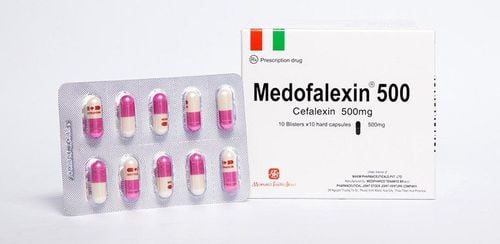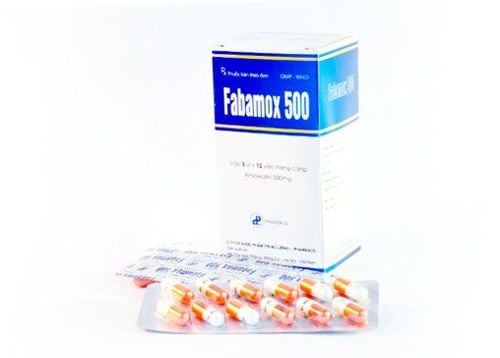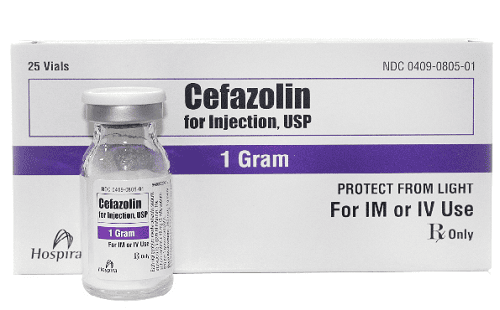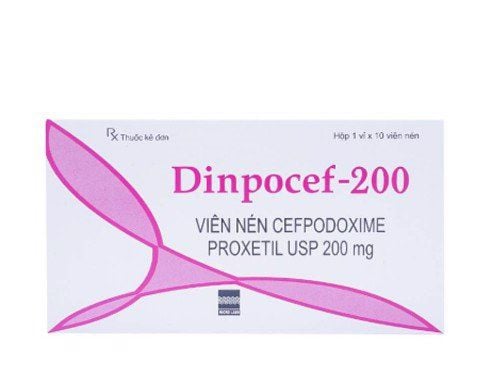This is an automatically translated article.
Egofixim drug contains the main active ingredient is cefixim, a 3rd generation cephalosporin antibiotic. The mechanism of action of the drug is to inhibit the synthesis of bacterial cell walls, thereby causing bacteria to be lysed. The drug is often indicated in the treatment of respiratory, urinary, ear-nose-throat, genital infections.
1. What is Egofixim?
Egofixim contains the main active ingredient is cefixime with a strength of 200mg. Cefixime is a 3rd generation cephalosporin antibiotic, the mechanism of action of the drug is by inhibiting the synthesis of the bacterial cell wall. Cefixime is highly stable to the hydrolysis of beta-lactamase enzymes encoded by genes located on plasmids and chromosomes. The stability to beta-lactamase of cefixime is higher than that of antibiotics of the same group such as cefaclor, cefoxitin, cefuroxime, cephalexin, cephradin. Cefixime is well absorbed from both the gastrointestinal tract and parenteral route. When taken orally about 40-50% of the drug is absorbed from the gastrointestinal system, absorption is increased when taken with food. The drug is widely distributed in body tissues and fluids, and penetrates well into the cerebrospinal fluid, especially when the meninges are inflamed.
2. Uses of Egofixim
Egofixim is indicated in the treatment of infections caused by susceptible strains of cefixime such as Streptococcus sp. Streptococcus pneumoniae, Branhamella catarrhalis, Neisseria gonorrhoeae, Klebsiella sp., Escherichia coli, Serratia sp., Proteus sp. and Haemophilus influenzae:
Cystitis, pyelonephritis Respiratory tract infections, including bronchitis, pneumonia. Ear, nose and throat infections: sinusitis, pharyngitis, otitis media, tonsillitis. Cholecystitis, biliary tract infection. Gynecological infections Uncomplicated gonorrhea.
3. Dosage of Egofixim
Adults, children > 12 years old or children weighing > 30 kg: treatment dose from 200-400 mg/day, taken once or divided into 2 times/day.
Children under 12 years old: 8 mg/kg/day, taken as a single dose or divided into 2 times/day.
Dosage in patients with renal impairment: adjust dose depending on creatinine clearance.
Creatinine clearance > 60 ml/min: use normal dose Creatinine clearance < 21 ml/min or patients on frequent peritoneal dialysis: 50% of the normal dose may be used. Note: Egofixim is contraindicated in patients with a history of hypersensitivity to any of the ingredients. part of the drug or with other cephem-containing antibiotics.
4. What are the side effects of Egofixim?
Frequency > 10%: Diarrhea (16%)
Frequency 2% to 10%: Abdominal pain, nausea, dyspepsia, flatulence, loose stools
Frequency <2%: Acute renal failure, reactive reactions protection, angioedema, candidiasis, dizziness, drug fever, eosinophilia, erythema multiforme, facial edema, fever, headache, hepatitis, hyperbilirubinemia, increased blood urea nitrogen, increased serum creatinine serum transaminase elevation, jaundice, leukopenia, prolonged prothrombin time, pruritus, pseudomembranous colitis, convulsions, serum sickness-like reactions, skin rash, Stevens-Johnson syndrome, decreased urination coccidiosis, toxic epidermal necrolysis, urticaria, vaginitis, vomiting
5. What are the precautions when using Egofixim?
Skin reactions: Serious skin reactions (eg, toxic epidermal necrolysis, Stevens-Johnson syndrome, drug rash with eosinophilia with systemic symptoms) have been reported. . If a reaction occurs, discontinue the drug and initiate supportive therapy. Hemolytic anemia: Immune-mediated hemolytic anemia (including death) has been reported. Monitor patients (including hematologic parameters and drug-induced antibody tests) for 2 to 3 weeks after treatment. If hemolytic anemia occurs during treatment, discontinue use immediately. Hypersensitivity: Hypersensitivity and anaphylaxis have been reported in patients receiving beta-lactams. Use with caution in patients with a history of hypersensitivity to cephalosporins, penicillins or other beta-lactams. If administered to penicillin-sensitive patients, use with caution and discontinue use if an allergic reaction occurs. Renal Impairment: May cause acute renal failure if renal failure occurs, discontinue the drug and initiate appropriate supportive therapy. Superinfection: Prolonged use of egofixim can lead to fungal or bacterial superinfections, including C. difficile diarrhea and pseudomembranous colitis. C.difficile infection has been observed after 2 months of antibiotic treatment. Renal Impairment: Egofixim should be used with caution in patients with renal impairment, as the risk of convulsions may be increased. Gastrointestinal disorders: Use with caution in patients with a history of gastrointestinal disease. Pregnancy: Cefixime crosses the placenta and can be detected in amniotic fluid. Overall, no increased risk of birth defects or other adverse outcomes for the fetus or mother has been observed following the use of cephalosporin antibiotics. Lactation: It is not known whether cefixime passes into breast milk. According to the manufacturer's recommendations, the decision to breastfeed during treatment should consider the risk of drug exposure to the infant, the benefits of breastfeeding, and the benefit of taking the drug to the mother. In summary, Egofixim is a 3rd generation cephalosporin antibiotic, commonly indicated in cases of respiratory, urinary, ear, nose and throat infections,... Like other cephalosporins, side effects are common. diarrhea when using egofixim. If patients experience unusual, prolonged side effects, they should discontinue use and contact their doctor or pharmacist for advice.
Please dial HOTLINE for more information or register for an appointment HERE. Download MyVinmec app to make appointments faster and to manage your bookings easily.













